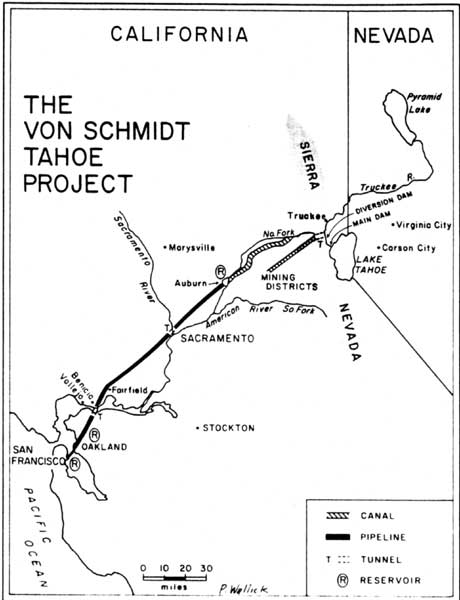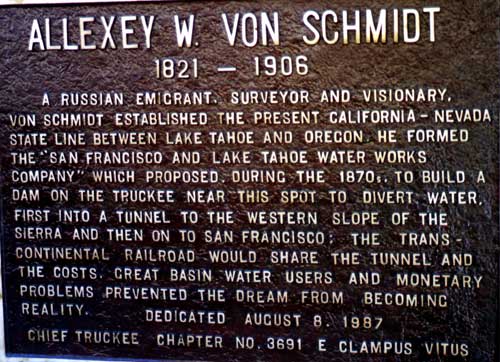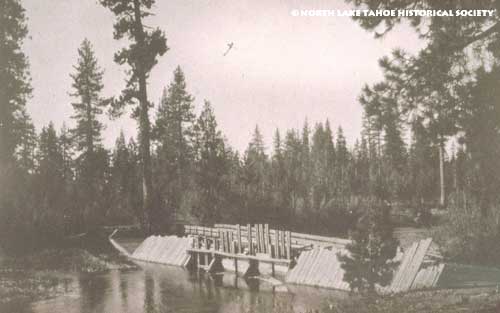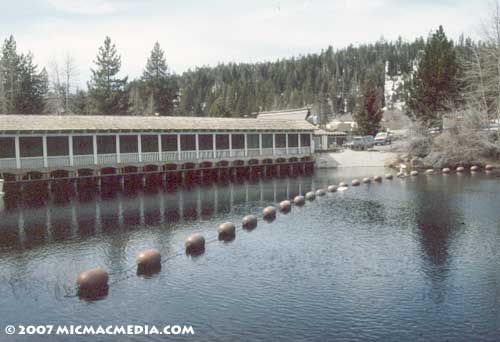|
Tahoe Nugget #116:
Tahoe's Grand Aqueduct
July 12, 2007
Lake Tahoe is renowned around the world for its spectacular scenic splendor, but ever since a crude rock and log splash dam was constructed several miles below its outlet to boost river flow and facilitate log
fluming, entrepreneurs have coveted the lake's pristine waters. Today the magnificent alpine lake is primarily operated as a reservoir for irrigation storage and municipal water use in Nevada. Together with a
handful of other public and privately owned reservoirs in the Truckee River system, Lake Tahoe provides about 75 percent of the water supply for the Reno-Sparks area.
In the 1860s, a San Francisco-based
engineer, Colonel Alexis von Schmidt, acquired a half-section of land surrounding Lake Tahoe's only outlet (headwaters of the Truckee River) and the right to appropriate 500 cubic feet per second of Tahoe water. It
was a subtle and inauspicious beginning to what Von Schmidt was intent on engineering, a water project considered nothing less than the "Grandest Aqueduct in the World."
The Prussian-born Von Schmidt exuded
optimism, confidence, and a driving energy that enabled him to succeed at projects others considered impossible. Trained as a civil engineer at American universities, in 1850 Von Schmidt landed a job as a United
States surveyor, mapping public lands and Spanish land grants throughout the new state of California.
In 1865, Von Schmidt and five other investors established the Lake Tahoe and San Francisco Water Works
Company to export the water of Lake Tahoe to the Bay Area, a distance of 163 miles. First among its articles of incorporation: "To take the waters of Lake Tahoe and the Truckee River and conduct it through canals,
tunnels, flumes and pipes, to the City of San Francisco." The plan required a diversion dam built about four miles downstream of the outlet, where a canal would branch off from the river and flow into Squaw Valley.
A five-mile tunnel bored northwest through the mountains would carry the water west of the Pacific Divide near Donner Pass. A complex system of pipes, tunnels, ditches, aqueducts and reservoirs would then transport
the water to a storage facility near San Francisco.
To fund the project Von Schmidt wanted the city to issue $10 million in bonds and he petitioned the U.S. Congress for a generous right-of-way package,
which included large checkerboard land grants as well as any inherent timber and stone resources.
Nevada residents and politicians were hardly thrilled at the thought of a private company diverting and exporting
water from the Truckee River to San Francisco so the state challenged Von Schmidt to prove his legal entitlement to Tahoe water. Von Schmidt assured Nevada that the state had nothing to fear; the six foot dam he
planned to erect at the Lake Tahoe outlet would store enough water to supply both states. He also argued that California had a superior water claim to Tahoe because two-thirds of the lake and its only outlet were
within its border.
During the summer of 1870, Von Schmidt's company built a stone and timber dam at the outlet. Because there was little support for the water diversion project in Truckee, an armed guard was
posted "to protect the dam against hot-headed residents." Truckee's factories and lumber mills used the river's current to power machinery, and to float logs down the Truckee River Canyon. As it was there was only
enough water volume to float logs for about four months of the year. Without the cheap transportation of Sierra timber, northern Nevada and Truckee would both suffer economically. An editorial in the Truckee Republican warned, "Violence would be used to prevent work on the project."
When Von Schmidt's proposal was submitted to legislators in Sacramento and Washington, D.C., it ran into strong resistance. Opponents argued that the federal government had no business subsidizing private corporations by giving away public lands. (Similar arguments were made regarding the generous government contracts issued for the construction of the first transcontinental railroad. Citizen groups and newspaper editorials complained that the proposed aqueduct reeked of corruption, so state and federal legislators killed the legislation.
Fortunately those of us who love Lake Tahoe, Alexis von Schmidt's "Grand Aqueduct" was never built, but the water needs of San Francisco continued to grow. In 1923, despite a storm of protest by John Muir and others, a controversial dam was built at Hetch Hetchy Valley in Yosemite National Park to provide water to San Francisco. Lake Tahoe had dodged a potentially lethal bullet.
Photo #1: Map of Von Schmidt's aqueduct project
Photo #2: Historic plaque near present-day Tahoe Dam
Photo #3: Early Tahoe dam, circa 1906
Photo #4: Modern dam can store six feet of water and that's a lot. Just one tenth of an inch of Tahoe's water equals 1,400,000 TONS of water; enough to supply the daily water requirements of a population of 3,500,000 people.
Photo #5: The damming of beautiful Hetch Hetchy Valley broke the heart naturalist John Muir. Note waterfalls.





|







